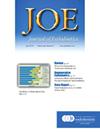The Effect of Novel Cryotherapy Technique on Postoperative Pain for Pulpotomy in Permanent Molars with Symptomatic Irreversible Pulpitis: A Randomized Controlled Trial
IF 3.6
2区 医学
Q1 DENTISTRY, ORAL SURGERY & MEDICINE
引用次数: 0
Abstract
Introduction
The purpose of this study was to evaluate the effect of cryotherapy application on postoperative pain in permanent molars with symptomatic irreversible pulpitis after full pulpotomy procedures.
Methods
Sixty-two patients with permanent maxillary and mandibular molars diagnosed with symptomatic irreversible pulpitis were included in the study. The teeth were randomly divided into 2 groups: the control group (n = 32) and the cryotherapy group (n = 30). In both groups, cotton pellets moistened with 2.5% sodium hypochlorite were used to achieve hemostasis. In the cryotherapy group, after hemostasis was achieved, the pulpotomy area was irrigated with saline solution at 2.5°C for 5 minutes. Then, in both groups, the pulp chamber was covered with Bio mineral trioxide aggregate+ (Cerkamed Company, Poland) and the composite restoration of the teeth (Clearfil Majesty Posterior, Kuraray Medical Inc., Tokyo, Japan) was completed. The participants were asked to rate the intensity of their postoperative pain via a Visual Analog Scale at 6, 12, 24, 48, and 72 hours. The data were analyzed using the Shapiro–Wilk, Levene's, Student t, Repeated Measures ANOVA and the Chi-square test.
Results
The basic demographic data and analgesic intake of the 2 study groups were similar. Compared with those in the control group, the postoperative pain scores at 6 and 12 hours were significantly lower in the cryotherapy group (P < .05). The postoperative pain scores at 24, 48, and 72 hours were similar in both study groups.
Conclusions
During vital pulp treatment, the cryotherapy application after hemostasis reduced postoperative pain in permanent molars with symptomatic irreversible pulpitis in the early period.
新型冷冻治疗技术对症状不可逆牙髓炎恒磨牙切开术术后疼痛的影响:一项随机对照试验。
简介:本研究的目的是评估冷冻治疗对全髓切开术后症状性不可逆牙髓炎的恒磨牙术后疼痛的影响。方法:对62例诊断为症状性不可逆性牙髓炎的上颌恒磨牙患者进行研究。将牙齿随机分为对照组(n = 32)和冷冻治疗组(n = 30)。两组均采用2.5% NaOCl湿润棉球止血。冷冻治疗组止血后,用2.5℃生理盐水冲洗切髓区5分钟。然后,两组牙髓腔均覆盖Bio MTA+ (Cerkamed公司,波兰),完成牙齿复合修复(Clearfil Majesty Posterior, Kuraray Medical Inc., Tokyo, Japan)。参与者被要求在6小时、12小时、24小时、48小时和72小时通过视觉模拟量表(VAS)评估他们的术后疼痛强度。采用Shapiro-Wilk、Levene’s、Student t、重复测量方差分析和卡方检验对数据进行分析。结果:两组患者的基本人口学资料及镇痛药摄入情况相似。与对照组比较,冷冻治疗组术后6h、12h疼痛评分均显著低于对照组(p < 0.05)。两组患者术后24h、48h、72h疼痛评分相似。结论:在恒磨牙生命髓治疗中,止血后冷冻治疗可减轻早期症状性不可逆性牙髓炎患者术后疼痛。
本文章由计算机程序翻译,如有差异,请以英文原文为准。
求助全文
约1分钟内获得全文
求助全文
来源期刊

Journal of endodontics
医学-牙科与口腔外科
CiteScore
8.80
自引率
9.50%
发文量
224
审稿时长
42 days
期刊介绍:
The Journal of Endodontics, the official journal of the American Association of Endodontists, publishes scientific articles, case reports and comparison studies evaluating materials and methods of pulp conservation and endodontic treatment. Endodontists and general dentists can learn about new concepts in root canal treatment and the latest advances in techniques and instrumentation in the one journal that helps them keep pace with rapid changes in this field.
 求助内容:
求助内容: 应助结果提醒方式:
应助结果提醒方式:


